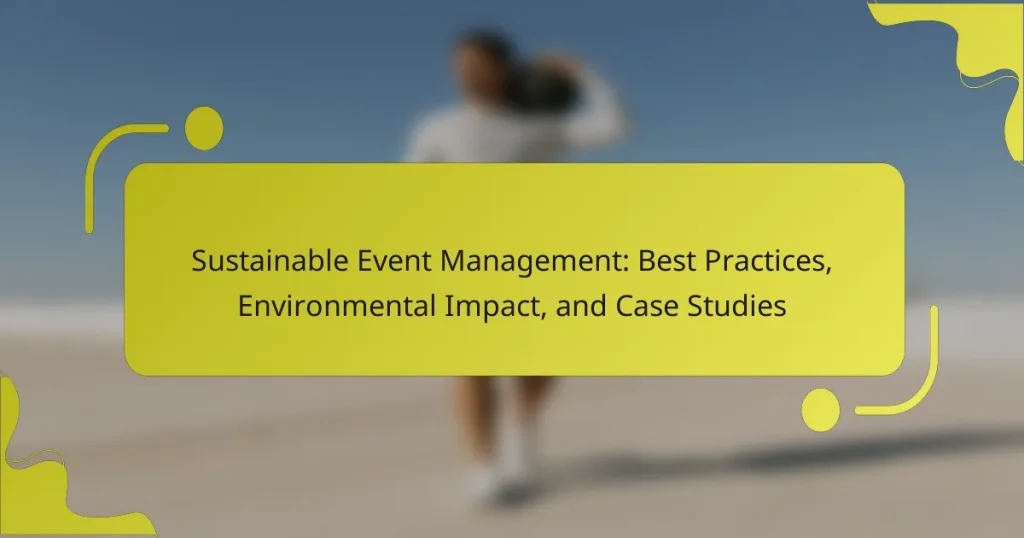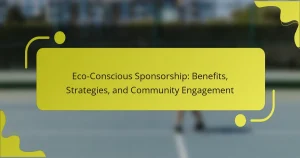Sustainable event management focuses on minimizing environmental impact while promoting social equity and economic viability. This article explores best practices for waste reduction, sustainable transportation options, and venue selection. It also examines innovative strategies and notable case studies, highlighting the measurable impacts of sustainability in events. Common challenges faced by organizers will be discussed, along with actionable solutions for effective implementation.
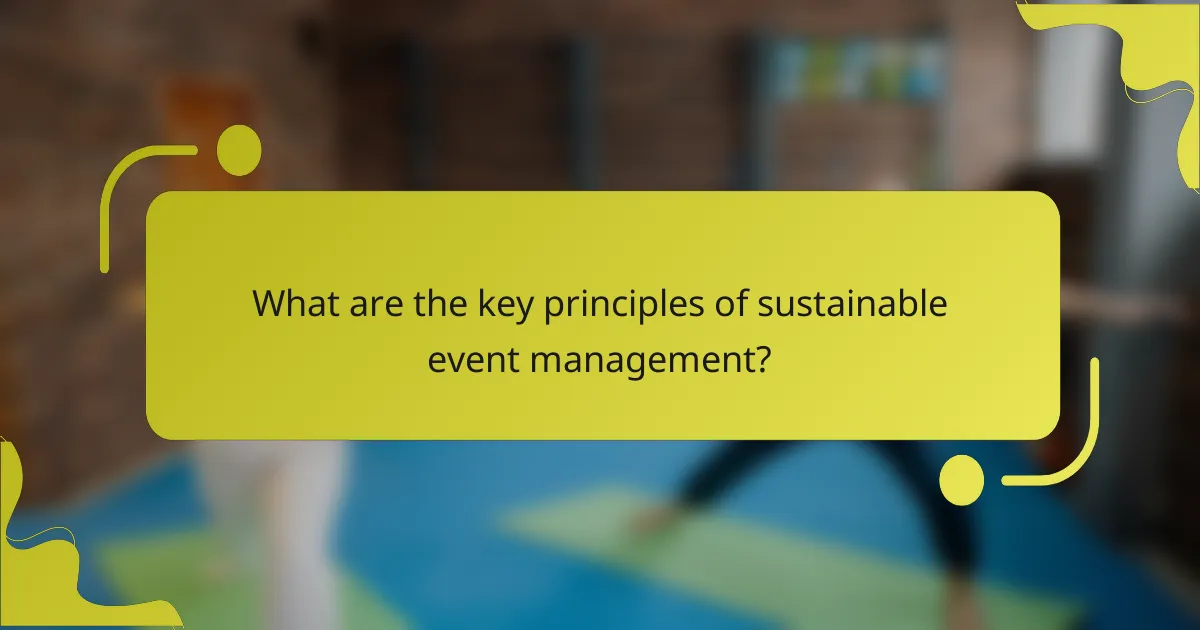
What are the key principles of sustainable event management?
Key principles of sustainable event management include minimizing environmental impact, promoting social equity, and ensuring economic viability. These principles guide planners to create events that are eco-friendly and socially responsible. Effective practices involve reducing waste, sourcing locally, and engaging communities. For example, using digital tickets can cut down on paper waste.
How does sustainability influence event planning?
Sustainability significantly influences event planning by prioritizing environmental responsibility and resource efficiency. Sustainable event management practices reduce waste, lower carbon footprints, and enhance community engagement. For example, using eco-friendly materials and promoting digital communication minimizes resource consumption. Additionally, incorporating local suppliers supports the economy and reduces transportation emissions. Case studies show that sustainable events can attract larger audiences and foster a positive brand image, proving that eco-conscious planning is beneficial for both the environment and business success.
Which stakeholders are involved in sustainable event management?
Key stakeholders in sustainable event management include event organizers, venue operators, suppliers, attendees, sponsors, and local communities. Each stakeholder plays a critical role in promoting environmental responsibility and enhancing social impact. Event organizers lead the planning and implementation of sustainable practices. Venue operators ensure facilities are eco-friendly and compliant with sustainability standards. Suppliers provide sustainable products and services, while attendees contribute by participating responsibly. Sponsors can influence sustainability through funding and partnerships. Local communities are impacted by events and can provide support or feedback on sustainability efforts.
What are the economic benefits of sustainable events?
Sustainable events provide significant economic benefits, including cost savings, increased sponsorship opportunities, and enhanced brand loyalty. By minimizing waste and energy consumption, organizations can lower operational costs. Sustainable practices attract sponsors interested in corporate social responsibility, expanding funding sources. Additionally, attendees often prefer brands committed to sustainability, leading to increased customer loyalty and repeat business.
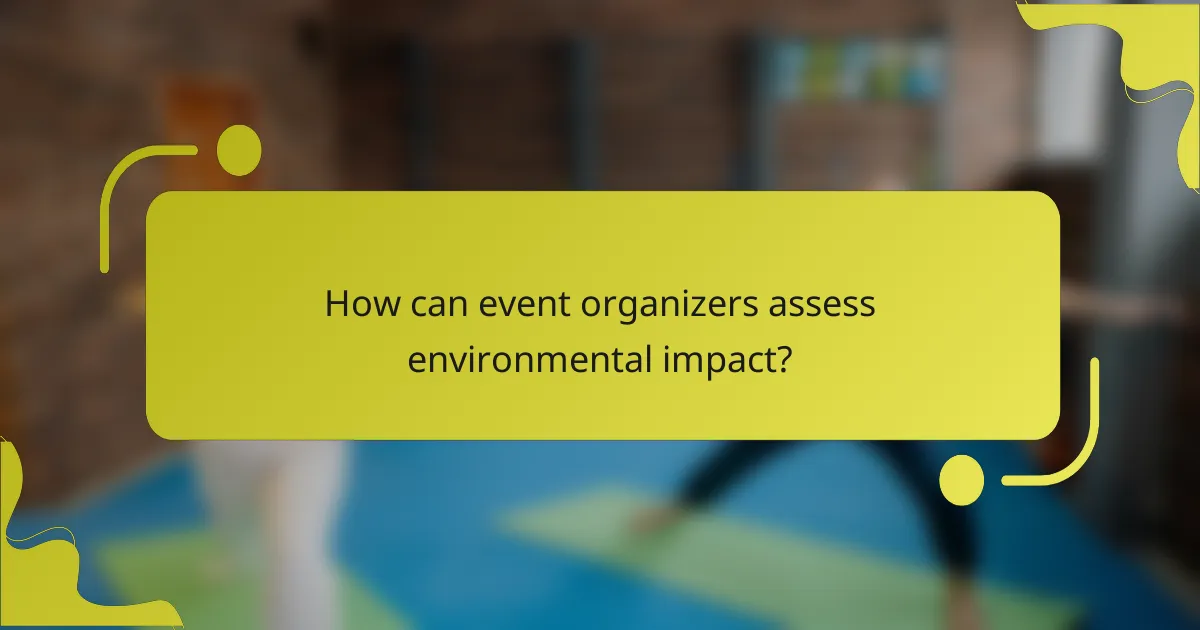
How can event organizers assess environmental impact?
Event organizers can assess environmental impact by using tools like carbon footprint calculators, waste audits, and sustainability assessments. These methods provide quantitative data on resource consumption and waste generation. For example, a carbon footprint calculator can estimate greenhouse gas emissions based on event size and logistics. Additionally, engaging with stakeholders can offer insights into local environmental concerns and potential improvements. Regular monitoring and reporting can enhance accountability and drive sustainable practices in future events.
What metrics are used to measure sustainability in events?
Sustainability in events is measured using metrics such as carbon footprint, waste diversion rates, and attendee satisfaction. These metrics assess environmental impact and social responsibility.
| Metric | Description | Value Example |
|—————————-|———————————————————–|—————————|
| Carbon Footprint | Total greenhouse gas emissions produced | 1,200 kg CO2 equivalent |
| Waste Diversion Rate | Percentage of waste diverted from landfills | 75% |
| Water Usage | Total water consumption during the event | 5,000 litres |
| Energy Consumption | Total energy used, often measured in kWh | 1,500 kWh |
| Attendee Satisfaction | Survey results measuring attendee perceptions of sustainability | 85% positive feedback |
| Local Sourcing Percentage | Amount of supplies sourced locally | 60% |
Which tools assist in evaluating environmental footprints?
Tools that assist in evaluating environmental footprints include carbon calculators, life cycle assessment software, and sustainability reporting platforms. These tools help organizations measure their environmental impact effectively.
| Tool | Functionality | Example |
|————————–|—————————————————|——————————-|
| Carbon Calculators | Estimate greenhouse gas emissions | Carbon Trust Calculator |
| Life Cycle Assessment | Analyze environmental impacts of products/services | SimaPro |
| Sustainability Reporting | Track and report sustainability metrics | GRI Standards |
| Energy Management Systems | Monitor and optimize energy usage | Energy Star Portfolio Manager |
| Waste Management Tools | Assess waste generation and disposal methods | WasteWise |
| Water Footprint Tools | Measure water usage and conservation strategies | Water Footprint Network |
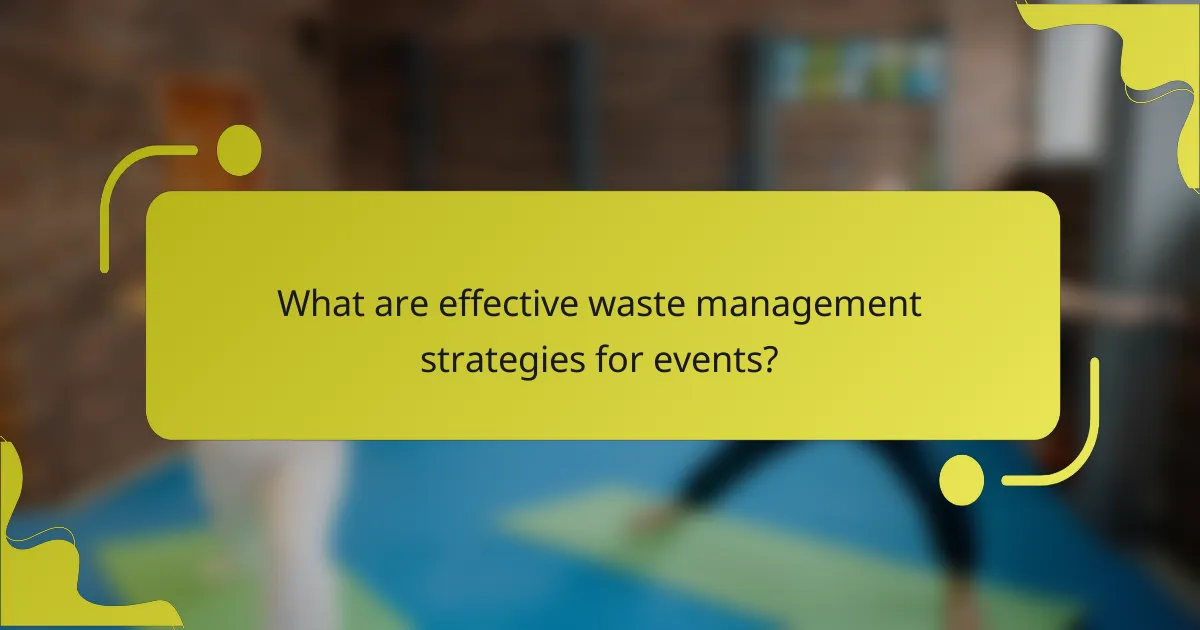
What are effective waste management strategies for events?
Effective waste management strategies for events include reducing waste generation, recycling, composting, and using digital materials. These practices minimize environmental impact and promote sustainability.
1. Reduce waste at the source by opting for digital tickets and materials.
2. Implement recycling stations throughout the venue to encourage proper disposal.
3. Offer composting options for food waste to enhance resource recovery.
4. Partner with local organizations for proper waste disposal and recycling services.
5. Educate attendees on sustainable practices to foster a culture of environmental responsibility.
How can recycling and composting be implemented at events?
Recycling and composting can be effectively implemented at events through strategic planning and clear communication. Organize designated recycling and composting stations with clear signage. Train staff and volunteers to assist attendees in proper waste disposal. Provide incentives for using these stations, such as discounts or prizes. Additionally, collaborate with local waste management services to ensure effective processing of materials.
What role do vendors play in sustainable waste management?
Vendors play a crucial role in sustainable waste management by implementing eco-friendly practices and reducing overall waste. They provide sustainable products, promote recycling, and support local communities. By collaborating with event organizers, vendors can minimize single-use plastics and enhance resource efficiency. This partnership fosters a circular economy, where materials are reused and repurposed, ultimately reducing environmental impact.
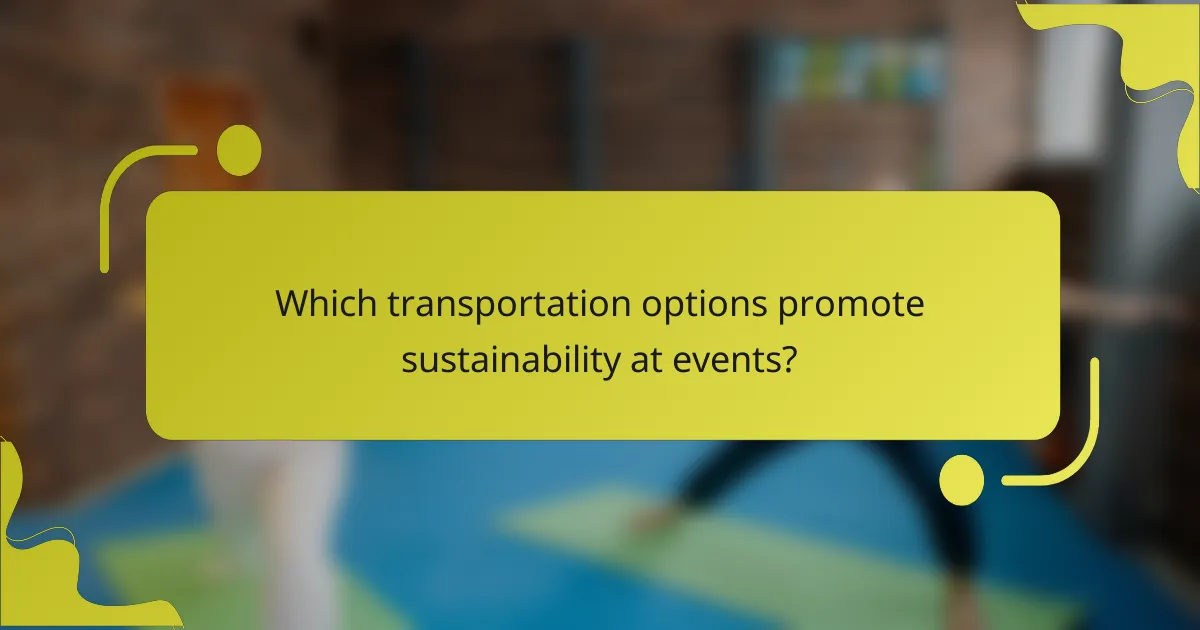
Which transportation options promote sustainability at events?
Sustainable transportation options for events include public transit, biking, carpooling, and electric vehicles. These choices reduce carbon emissions and promote eco-friendly practices.
Public transit effectively minimizes individual car use, lowering traffic congestion and emissions. Biking encourages physical activity and provides a zero-emission transport alternative. Carpooling maximizes vehicle occupancy, reducing the total number of cars on the road. Electric vehicles offer a sustainable option with lower emissions compared to traditional vehicles.
Incorporating these transportation methods enhances the overall sustainability of events, aligning with best practices in sustainable event management.
How can public transportation be integrated into event planning?
Integrating public transportation into event planning enhances accessibility and sustainability. Event organizers can collaborate with local transit authorities to develop special routes or schedules that accommodate attendees.
Utilizing public transport reduces carbon emissions and traffic congestion. It also encourages higher attendance rates by making events more reachable. Additionally, providing information on public transit options in promotional materials can increase awareness and usage among participants.
Incorporating shuttle services from key transit points can further streamline access, ensuring a seamless experience. Tracking attendance via transit usage can also provide valuable data for future events.
What are the benefits of encouraging carpooling and shuttles?
Encouraging carpooling and shuttles reduces traffic congestion and lowers carbon emissions. This practice promotes sustainable event management by minimizing the environmental impact of transportation. Carpooling can decrease the number of vehicles on the road, which leads to reduced fuel consumption and air pollution. Additionally, shuttles can efficiently transport large groups, enhancing accessibility and convenience for attendees. Studies show that events utilizing these methods can lower their overall carbon footprint significantly, supporting eco-friendly initiatives.
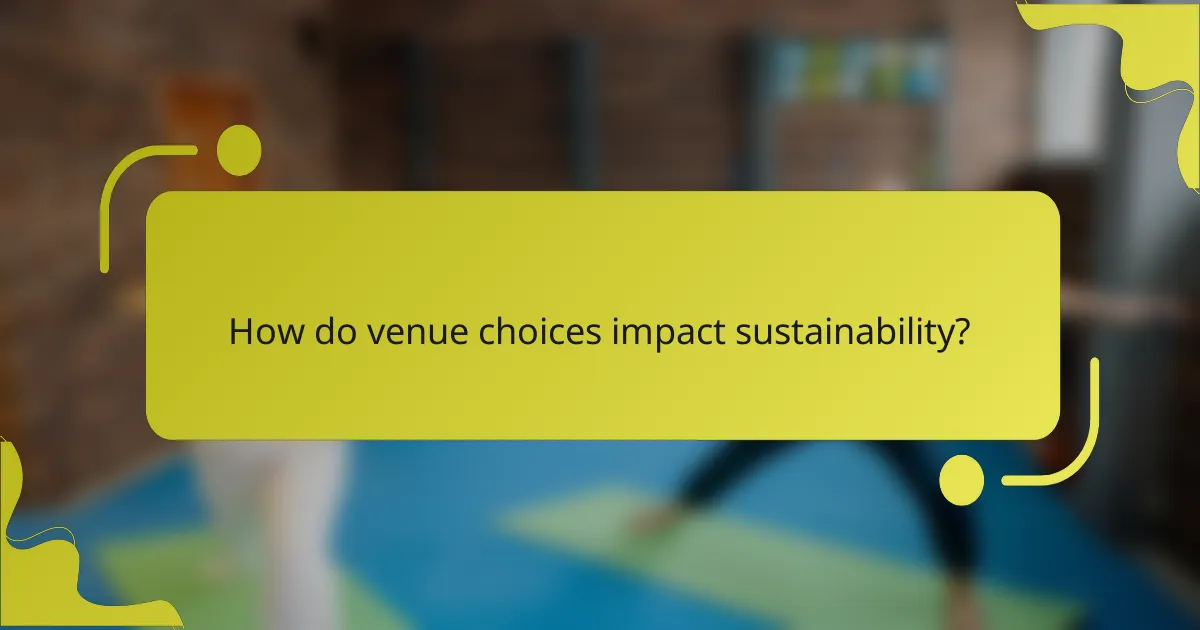
How do venue choices impact sustainability?
Venue choices significantly impact sustainability by influencing resource consumption, waste generation, and carbon footprint. Selecting venues with sustainable practices, such as energy-efficient systems and waste reduction programs, enhances overall event sustainability. For instance, venues that prioritize local sourcing minimize transportation emissions. Additionally, the location of the venue affects attendee travel, further impacting environmental outcomes. Sustainable venues often incorporate green certifications, showcasing their commitment to eco-friendly practices. As a result, choosing the right venue is crucial for reducing the environmental impact of events.
What features should be considered when selecting a sustainable venue?
When selecting a sustainable venue, consider its environmental certifications, energy efficiency, waste management practices, accessibility, and local sourcing policies. These features significantly impact sustainability.
| Feature | Description |
|—————————–|—————————————————————|
| Environmental Certifications | Verify certifications like LEED or BREEAM for sustainability. |
| Energy Efficiency | Assess the venue’s energy use and renewable energy sources. |
| Waste Management Practices | Evaluate recycling programs and waste reduction initiatives. |
| Accessibility | Ensure the venue accommodates all guests, enhancing inclusivity.|
| Local Sourcing Policies | Check for partnerships with local suppliers to minimize transport emissions. |
Which certifications indicate a venue’s commitment to sustainability?
Certifications indicating a venue’s commitment to sustainability include LEED, ISO 20121, Green Key, and EarthCheck. These certifications reflect a venue’s adherence to environmental best practices and sustainable event management.
| Certification | Focus Area | Key Benefit |
|—————|————|————-|
| LEED | Building efficiency | Reduces energy consumption |
| ISO 20121 | Event sustainability | Ensures sustainable event practices |
| Green Key | Eco-friendly operations | Promotes responsible tourism |
| EarthCheck | Environmental performance | Improves sustainability reporting |
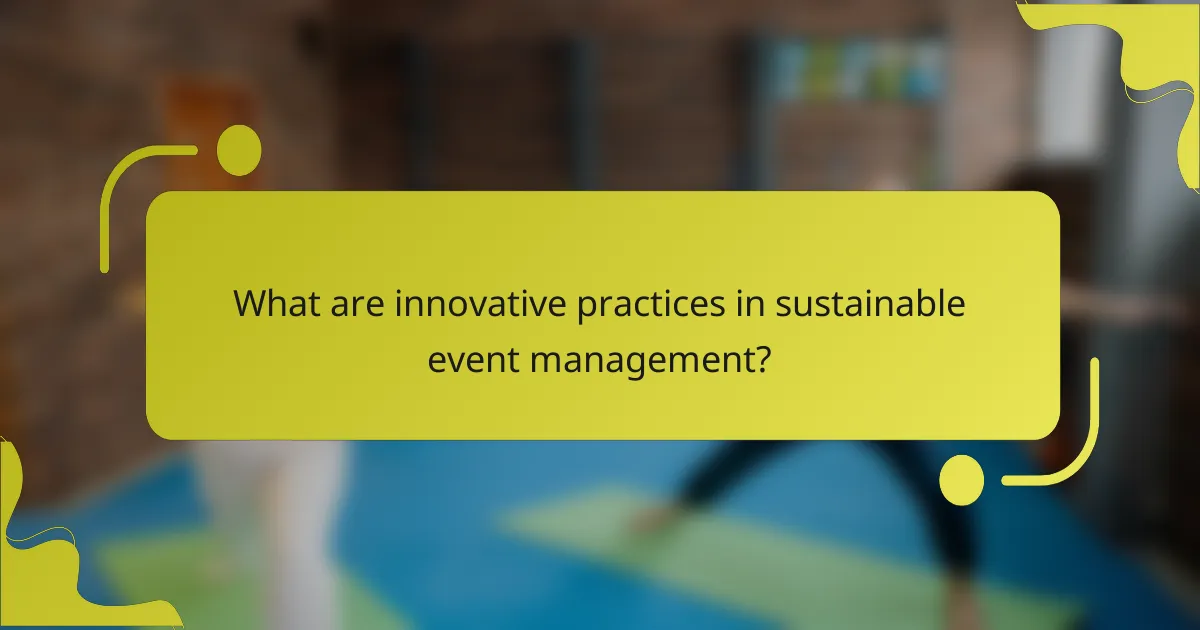
What are innovative practices in sustainable event management?
Innovative practices in sustainable event management include zero waste initiatives, digital ticketing, and sustainable sourcing. These approaches minimize environmental impact and enhance attendee experience. For example, using eco-friendly materials reduces waste, while virtual platforms lower carbon footprints. Implementing such practices can lead to significant resource savings and improved brand reputation.
How can technology enhance sustainability in events?
Technology can significantly enhance sustainability in events by optimizing resource usage and minimizing waste. Innovative tools like event management software streamline logistics, reducing carbon footprints. Virtual platforms enable remote participation, decreasing travel emissions. Real-time data analytics help track energy consumption, allowing for immediate adjustments. Sustainable materials and digital ticketing further reduce environmental impact.
Which unique initiatives have been successfully implemented?
Several unique initiatives have been successfully implemented in sustainable event management. For instance, the use of zero-waste strategies has transformed events by minimizing landfill contributions. Another initiative is the integration of local sourcing, which reduces transportation emissions and supports regional economies. Additionally, events have adopted carbon offset programs to neutralize their environmental impact. Lastly, innovative technology solutions, like virtual attendance options, have decreased the need for travel, further promoting sustainability.
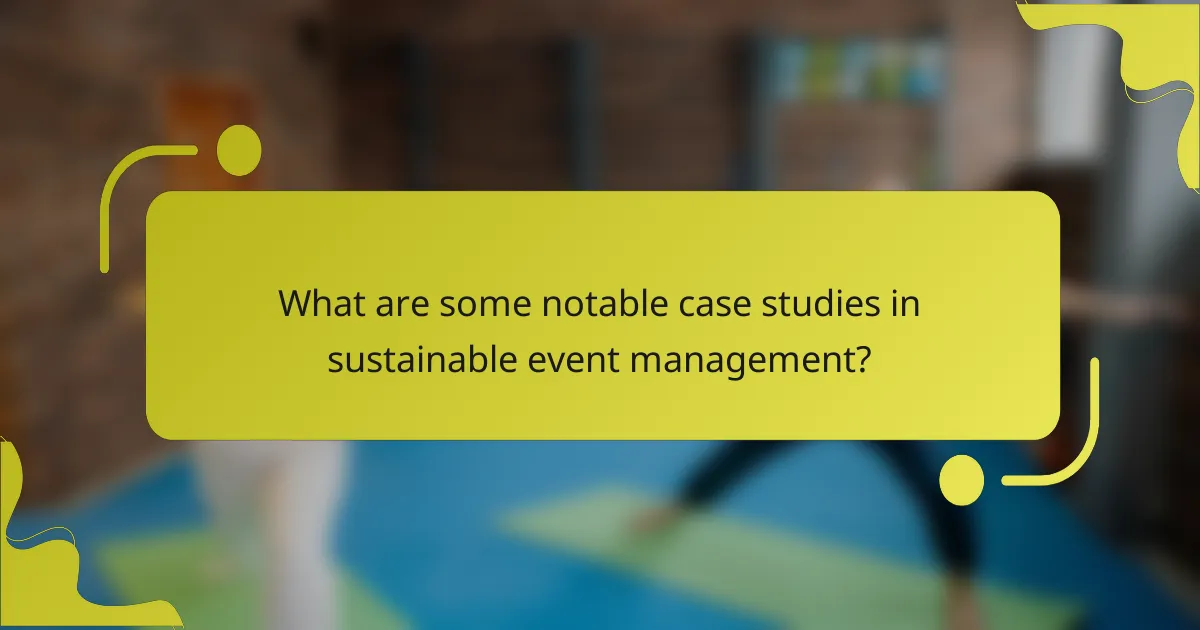
What are some notable case studies in sustainable event management?
Notable case studies in sustainable event management include the 2012 London Olympics, which achieved a 98% waste diversion rate, and the 2019 Green Sports Alliance Summit, emphasizing carbon neutrality. The 2020 Tokyo Olympics implemented strict sustainability guidelines, aiming for zero waste. Additionally, the Coachella Valley Music and Arts Festival has made significant strides in reducing plastic use and promoting recycling initiatives. Each case showcases innovative practices and measurable environmental impacts, highlighting the importance of sustainability in large-scale events.
Which events have set benchmarks for sustainability?
Several events have established benchmarks for sustainability through innovative practices. Notable examples include the 2012 London Olympics, which implemented extensive waste management strategies, and the 2014 Sochi Winter Olympics, recognized for its carbon-neutral initiatives. The Green Sports Alliance has also highlighted various sports events that prioritize eco-friendly measures. Additionally, the COP26 climate conference in 2021 set a precedent for sustainable event management by focusing on reducing carbon footprints and promoting renewable energy solutions. These events demonstrate effective sustainability strategies that can be modeled by future gatherings.
What lessons can be learned from successful sustainable events?
Successful sustainable events teach valuable lessons in resource management, stakeholder engagement, and innovation. They highlight the importance of minimizing waste, using renewable resources, and fostering community involvement. For example, events that prioritize local vendors reduce carbon footprints and support the economy. Engaging participants through education on sustainability practices enhances awareness and encourages behavioral change. Additionally, measuring environmental impact through metrics allows for continuous improvement. These practices create a model for future events, demonstrating that sustainability can be both feasible and beneficial.
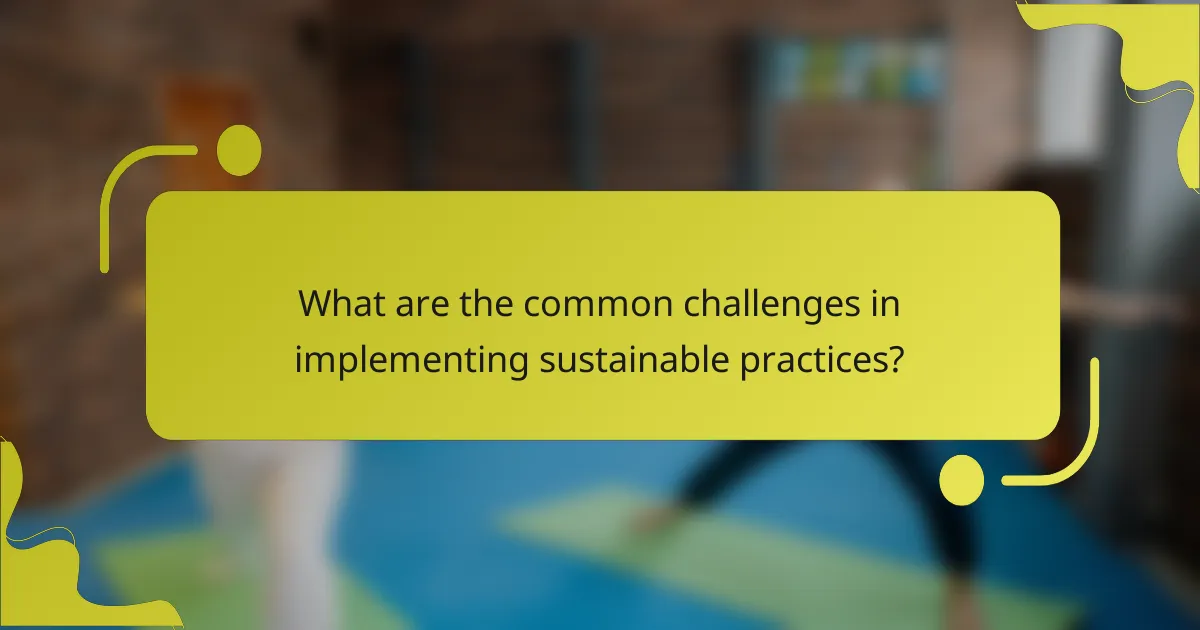
What are the common challenges in implementing sustainable practices?
Common challenges in implementing sustainable practices include high initial costs, lack of stakeholder engagement, limited resources, and insufficient knowledge. These obstacles can hinder effective sustainable event management. For example, financial constraints may prevent the adoption of eco-friendly technologies. Additionally, engaging participants and vendors in sustainable initiatives often proves difficult due to varying levels of commitment.
How can budget constraints affect sustainability efforts?
Budget constraints can significantly hinder sustainability efforts in event management. Limited financial resources often lead to compromises on eco-friendly practices such as waste reduction, sustainable sourcing, and energy-efficient solutions. As a result, events may rely on cheaper, less sustainable options that increase their environmental impact. Additionally, budget limitations can restrict the implementation of innovative technologies that promote sustainability, ultimately undermining long-term goals. Prioritizing sustainability within a constrained budget requires strategic planning and creative solutions to ensure minimal environmental harm while managing costs effectively.
What resistance might organizers face from stakeholders?
Organizers may face resistance from stakeholders due to concerns over costs, logistical challenges, and differing sustainability priorities. Stakeholders may prioritize immediate financial returns over long-term environmental benefits. Additionally, resistance can arise from a lack of awareness or understanding of sustainable practices. Competing interests and limited resources can further complicate collaboration. Engaging stakeholders early and addressing their concerns can mitigate resistance.

What are the best practices for achieving sustainability in events?
To achieve sustainability in events, implement practices that minimize environmental impact. Focus on reducing waste, conserving energy, and promoting local resources.
1. Choose eco-friendly venues that prioritize sustainability.
2. Use digital tickets and materials to reduce paper waste.
3. Implement recycling and composting stations at the event.
4. Source food and beverages from local, sustainable suppliers.
5. Encourage attendees to use public transport or carpool.
6. Measure and report the event’s carbon footprint to improve future practices.
Which resources can assist in developing a sustainable event strategy?
Resources for developing a sustainable event strategy include industry guidelines, case studies, and sustainability certification programs. These resources provide insights into best practices, environmental impacts, and innovative solutions.
1. Industry Guidelines: Organizations like the Event Sustainability Council offer frameworks for sustainable practices.
2. Case Studies: Analyzing successful events, such as the London 2012 Olympics, reveals effective strategies and outcomes.
3. Certification Programs: Programs like ISO 20121 provide standards for sustainable event management, ensuring compliance and best practices.
4. Online Courses: Platforms like Coursera and LinkedIn Learning offer courses on sustainable event management, enhancing knowledge and skills.
5. Networking Groups: Joining associations like the International Live Events Association fosters connections with sustainability experts and resources.
6. Research Publications: Journals and reports on sustainable event management provide data and trends to inform strategy development.
What expert tips can enhance the sustainability of events?
Implementing expert tips can significantly enhance the sustainability of events. Focus on reducing waste, sourcing local materials, and promoting eco-friendly transportation options.
1. Choose a sustainable venue that prioritizes energy efficiency and waste reduction.
2. Use digital tools for ticketing and communication to minimize paper use.
3. Incorporate local food and beverage suppliers to reduce carbon footprint.
4. Encourage attendees to use public transport or carpooling for travel.
5. Implement a comprehensive recycling and composting program at the event.
What common mistakes should be avoided in sustainable event management?
Common mistakes in sustainable event management include inadequate planning, neglecting stakeholder engagement, overlooking waste management, and failing to measure environmental impact. These errors can diminish the event’s sustainability efforts.
1. Inadequate planning: Not setting clear sustainability goals can lead to ineffective practices.
2. Neglecting stakeholder engagement: Failing to involve participants and vendors can hinder collaboration.
3. Overlooking waste management: Not implementing proper waste disposal strategies results in increased landfill waste.
4. Failing to measure environmental impact: Without assessment, it is difficult to gauge success and improve future events.
5. Ignoring local resources: Relying on distant suppliers increases carbon footprint unnecessarily.
6. Underestimating communication: Lack of information can lead to confusion about sustainable practices among attendees.
